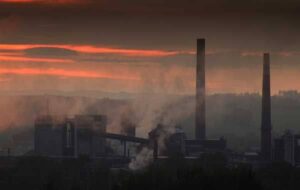According to a report published yesterday by Oxford University’s Our World in Data platform, Nigeria is 8th most polluted country in the world with 71.80 microgramme (μg) and Nepal most polluted country with 99.73 μg.
Nigeria, last year, ranked 18th in the list of most polluted countries in the world, with an average of 34 microgrammes per cubic metre of particulate matter concentration.
The concentration of an air pollutant is given in microgrammes (one-millionth of a gramme) per cubic metre air or µg/m3.
Niger is second with 94.05 μg, Qatar third with 91.19 μg, India fourth with 90.87 μg, Saudi Arabia fifth with 87.95 μg, Egypt six with 87 μg, Cameroun seventh with 75.01 μg, Bahrain ninth with 70.82 μg and Chad tenth with 66.03 μg.
Experts called the figure from Nepal, which is nearly 20-times higher than the World Health Organisation’s (WHO) guideline limits of 5μg/m3 — “alarming”.
According to the United Nations (UN), this is due to poorer countries tending to have weaker laws around air pollution, lower vehicle emission standards and higher numbers of coal power stations.
Following Nepal, Niger (94.05μg/m3) and Qatar (91.19μg/m3) had the highest concentration of PM2.5.
The researchers said the high concentrations across North Africa are ‘very high’, partly due to ‘drier conditions with more sand and dust sources’.
Rounding off the top five countries with the poorest air quality is India, where the population of 1.4billion was exposed to 90.87μg/m3 of PM2.5, and Saudi Arabia, where 87.95μg/m3 was logged.
Except for Qatar, each of the top five countries’ PM2.5 levels had increased since 1990 — indicating that efforts to improve pollution levels has been unsuccessful in some nations.
Of the top five offenders, Nepal had the biggest jump in levels of PM2.5, with the figure skyrocketing by 12.13μg/m3. This jump is more than twice the average yearly exposure to PM2.5 in Finland.
Egypt (87μg/m3), Cameroon (72.79μg/m3), Nigeria (71.80μg/m3), Bahrain (70.82μg/m3) and Chad (66.03μg/m3) were also among the nations with the poorest air quality.
Meanwhile, Finland recorded just three deaths per 100,000 caused by pollution exposure — the lowest in the world.
Pollution is one of the world’s largest health problems, behind 6.67million deaths worldwide in 2019, making it the third biggest killer, according to the WHO.
Taking the top spot for the world’s biggest cause of death in 2019 was high blood pressure (10.85 million), which was closely followed by smoking (7.69million), according to a Global Burden of Disease study published in The Lancet.
The ‘Our World in Data’ figures also revealed national death rates due to outdoor air pollution in 2019.
Despite Nepal logging the worst levels of PM2.5, it was Uzbekistan that recorded the highest fatality rate.
The Central Asian country, home to 20.5 million people, reported 179 deaths per 100,000 people — more than double the 81 seen in 1990.
It is closely followed by Egypt, where the death rate was 161, and Qatar (133).
Air pollution is one of the largest threats to health across the world and although access to clean air is a fundamental human right, air pollution accounts for about seven million deaths around the world yearly. Air pollution contributed to 30 percent of all pneumonia deaths in 2019; with 59 per cent contamination from household sources and 44 per cent from outdoor sources.






